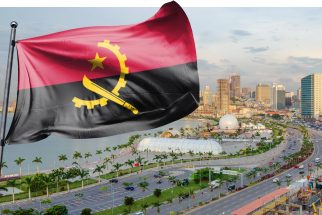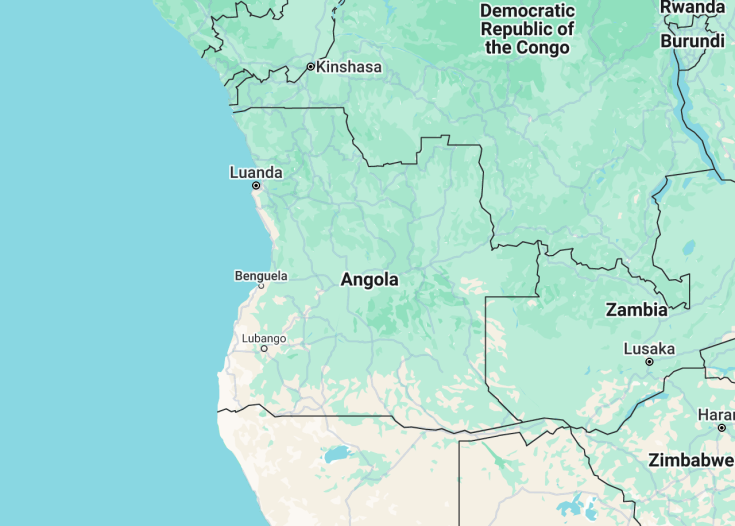Angola, known for its rich cultural heritage and breathtaking natural beauty, is a hidden gem waiting to be explored. From its vibrant capital city, Luanda, to the stunning beaches along the Atlantic coast, Angola offers an array of experiences for travelers. With its diverse wildlife reserves, including the Kissama National Park, visitors can embark on thrilling safaris and witness majestic elephants, lions, and giraffes in their natural habitats. The country’s historical sites, such as the Fortress of São Miguel and the Colonial Museum, provide a glimpse into its fascinating past. Angola is a destination that promises adventure, relaxation, and a deep appreciation for its unique heritage.
For a true taste of Angola, don’t miss trying the local cuisine, which features delicious dishes like muamba de galinha (chicken stew) and calulu (a traditional fish dish).
When visiting Angola, make sure to explore the stunning landscapes of the Bengo Province, with its breathtaking waterfalls and lush forests.
Top destinations in Angola
Angola: The Jewel of Africa
| Capital | Luanda |
| Time in Angola | GMT+1 |
| Language spoken | Portuguese |
| Population | 32 million (as of 2021, source: World Bank) |
| Religion | Roman Catholicism (41%) Protestantism (38%) African Traditional Religions (12%) Others (9%) |
| Currency | Kwanza (AOA) |
| Airports | Quatro de Fevereiro Airport Cabinda Airport Lubango Mukanka Airport |
Angola, a nation whose name evokes images of vast landscapes and vibrant cultures, lies nestled along the southwestern coast of Africa. While it’s well known today for its oil reserves and diamond mines, its historical significance is much deeper. Colonized by the Portuguese in the 15th century, it was a center for the transatlantic slave trade for over 400 years. It was not until 1975 that Angola gained its independence, after which it was engulfed in a civil war that lasted for nearly three decades. Today, while still bearing the scars of its tumultuous past, Angola is a country of rebirth and resilience, rich in cultural diversity, natural beauty, and economic potential.
Where is Angola located?
Angola is located in the southwestern part of Africa, bordered by the Atlantic Ocean on the west and neighboring countries like Namibia, Zambia, and the Democratic Republic of Congo.
What is Angola famous for?
Angola is renowned for its rich oil and diamond reserves, mesmerizing landscapes including the Kalandula Falls, and its vibrant music genre, Kizomba.
History
(Pre-colonial Era) Ancient Kingdoms
The territory now known as Angola was once home to various Bantu-speaking tribes. These groups migrated into the region from the north around 1000 AD and established several kingdoms, including the Kingdom of Kongo, the Lunda Empire, and the Kingdom of Ndongo.
(1482-1655) Early European Contact
European contact began with the arrival of the Portuguese explorer Diogo Cão in 1482. The Portuguese established relations with the Kingdom of Kongo and other states. Over time, they sought to control the trade routes and established forts along the coast.
(1655-1951) Portuguese Colonization
By the mid-17th century, Portugal had taken control of parts of the coastal regions, leading to conflicts with local kingdoms. Over the next centuries, they expanded their territories inland, often engaging in the slave trade. Angola became a prime source for the transatlantic slave trade, which deeply affected its indigenous societies.
(1951-1975) Struggle for Independence
In 1951, Portugal upgraded the status of Angola to an overseas province. However, the winds of change sweeping across Africa led to a protracted liberation struggle against Portuguese rule. Three main liberation movements emerged: MPLA, FNLA, and UNITA. These groups fought both the colonial power and each other.
(1975-present) Post-independence Era
Angola gained independence in 1975, but internal strife continued. A long-lasting civil war between MPLA and UNITA erupted, lasting until 2002. With peace finally established, Angola began a process of rebuilding and has since become one of Africa’s major oil producers, leading to significant economic growth, albeit with challenges.
Visit Angola
What to see and do in Angola
When visiting Angola, there are several attractions and activities that shouldn’t be missed:
- Explore the capital city of Luanda, with its mix of modern skyscrapers and colonial architecture. Visit the Fortaleza de São Miguel, a 16th-century fortress, and take a stroll along the picturesque Marginal Avenue.
- Discover the natural beauty of Angola by visiting the national parks, such as Bicauri National Park and Kissama National Park. These parks offer opportunities for wildlife viewing, birdwatching, and hiking.
- Relax on the stunning beaches along the Angolan coastline, including the popular Baía Azul and Ilha do Mussulo. Enjoy water sports such as snorkeling, diving, and fishing.
- Immerse yourself in the local culture by visiting traditional markets like Roque Santeiro Market in Luanda. Experience the vibrant music and dance scene, with styles like kizomba and semba.
- Learn about Angola’s history by visiting historical sites like the Slave Route in Mbanza Kongo and the National Museum of Slavery in Luanda. These sites provide insights into the country’s colonial past and the tragic legacy of the slave trade.
Events in Angola
Angola hosts various events and festivals throughout the year, offering visitors a chance to experience the country’s rich cultural traditions. Some notable events include:
- Carnaval de Luanda: Held in February, this lively carnival features colorful parades, music, and dancing.
- National Heroes’ Day: Celebrated on September 17th, this public holiday honors the national heroes of Angola and includes ceremonies and commemorations.
- Festival Internacional de Música do Sumbe: This music festival takes place in Sumbe, attracting local and international artists for performances and music workshops.
- Angola Fashion Week: Showcasing the talent of Angolan designers, this fashion week event highlights the country’s growing fashion industry.
These events provide a glimpse into the vibrant culture of Angola and its people. Visitors can immerse themselves in the festivities and experience the warmth and hospitality of the Angolan people.
Best time to visit Angola
The best time to visit Angola is during the dry season, which runs from May to October. This period offers pleasant temperatures and lower humidity, making it ideal for outdoor activities and wildlife viewing. The wet season, from November to April, brings heavy rainfall and can make travel and outdoor exploration more challenging. However, the wet season also offers the opportunity to witness the lush green landscapes and enjoy the country’s waterfalls and rivers at their fullest. It’s important to note that Angola is a large country with diverse climates, so the specific weather conditions may vary depending on the region you plan to visit.
Is Angola worth visiting?
Angola is definitely worth visiting for travelers seeking unique experiences and a deeper understanding of African history and culture. The country’s rich cultural heritage, diverse landscapes, and welcoming people make it an intriguing destination. However, it’s important to be aware of the challenges that Angola still faces, including issues of poverty, inequality, and corruption. Travelers should take necessary precautions and be mindful of safety and security concerns. Additionally, it’s essential to respect local customs and traditions when visiting Angola. Overall, Angola offers a blend of natural beauty, historical significance, and cultural vibrancy that can make for a rewarding and memorable travel experience.
Common questions
What are the must-visit attractions in Angola?
- Kalandula Falls – A stunning waterfall located on the Lucala River.
- Mussulo Island – A beautiful island known for its white sandy beaches and crystal clear waters.
- Tundavala Gap – A breathtaking natural formation featuring a deep gorge and stunning views.
- Iona National Park – A diverse and unique national park home to various wildlife species.
- Benguela – A coastal city with a rich history and beautiful architecture.
What is the currency of Angola?
What are some traditional dishes to try in Angola?
- Moamba de Galinha – A delicious chicken stew made with palm oil and served with rice or funge (a staple food made from cassava or cornmeal).
- Calulu – A popular dish made with dried fish, vegetables, and spices.
- Muamba de Ginguba – A rich peanut stew, typically made with meat or fish.
- Funge – A staple food similar to polenta, made from cassava or cornmeal and served with various sauces.
- Piri Piri Chicken – Grilled or roasted chicken marinated in a spicy chili sauce.
These are just a few examples of the delicious traditional dishes you can try in Angola. Make sure to explore the local food scene and try different specialties during your visit.
Is it safe to travel to Angola?
- Avoid walking alone at night, especially in unfamiliar or poorly lit areas.
- Keep your valuables secure and be mindful of pickpockets in crowded areas.
- Follow the advice of local authorities and stay updated on any travel advisories.
- Respect local customs and traditions.
- Travel with a reputable tour operator or guide, especially when visiting remote areas.
By taking these precautions and staying informed, your trip to Angola can be a safe and enjoyable experience.
What are the popular activities to do in Angola?
- Visiting the stunning Kalandula Falls and taking in the awe-inspiring views.
- Exploring the beautiful beaches of Mussulo Island and indulging in water sports such as snorkeling and diving.
- Hiking and exploring the Tundavala Gap, a natural wonder with breathtaking views.
- Embarking on a safari in Iona National Park to spot diverse wildlife, including elephants, antelopes, and birds.
- Exploring the historic city of Benguela and admiring its colonial architecture.
These are just a few examples of the popular activities to do in Angola. The country has a rich cultural heritage and natural beauty, offering something for every type of traveler.
What are the visa requirements for visiting Angola?
What is the local language spoken in Angola?
What is the climate like in Angola?
What are some traditional arts and crafts in Angola?
- Wood carvings – Intricately carved wooden statues and masks depicting traditional motifs and figures.
- Handwoven baskets and mats – Crafted using traditional techniques and often featuring vibrant colors and patterns.
- Pottery – Handmade ceramic pottery with unique designs and shapes.
- Textiles – Colorful fabrics and textiles woven with traditional patterns and motifs.
- Beadwork – Handcrafted jewelry and accessories adorned with beads and other decorative elements.
These traditional arts and crafts showcase the creativity and cultural heritage of Angola and make for unique souvenirs.
What is the healthcare system like in Angola?
What are the transportation options in Angola?
- Taxis – Taxis are widely available in major cities and can be flagged down on the street or hired from taxi stands. It is advisable to negotiate the fare in advance or insist on using the meter.
- Buses – There are both local and long-distance bus services in Angola. Local buses are a budget-friendly option for getting around within cities, while long-distance buses connect different regions.
- Car rental – Rental cars are available in major cities, and having a car gives you the flexibility to explore at your own pace. However, it is important to note that traffic can be chaotic, and driving conditions in some areas may be challenging.
- Motorcycle taxis – In some areas, motorcycle taxis, known as “taxi motos,” are a common mode of transportation. They can be a convenient option for short distances, but it’s important to ensure the driver has a helmet and necessary safety equipment.
These are just a few of the transportation options available in Angola. It’s important to consider factors such as safety, cost, and convenience when choosing the best mode of transportation for your needs.











